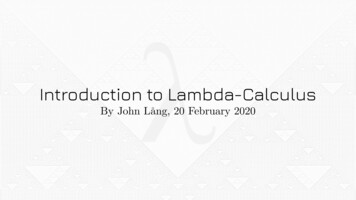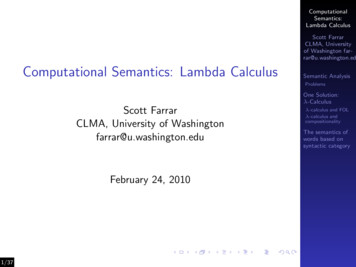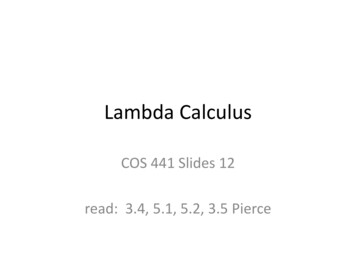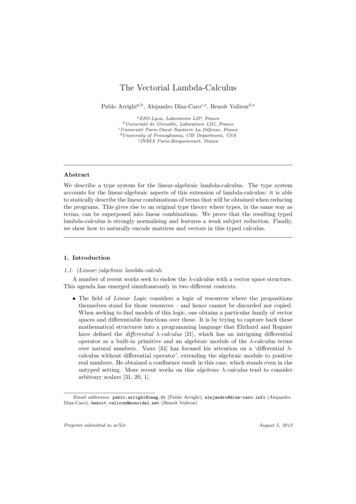
Transcription
The Lambda CalculusRonghui GuSpring 2022Columbia University Course website: https://verigu.github.io/4115Spring2022 These slides are borrowed from Prof. Edwards.
What is the lambda calculus?The lambda calculus can be called the smallest universalprogramming language of the world (by Alonzo Church, 1930s). a single transformation rule (variable substitution) a single function definition scheme any computable function can be expressed and evaluatedusing this formalism.1
Lambda ExpressionsFunction application written in prefix form. “Add four and five”is( 4 5)Evaluation: select a redex and evaluate it:( ( 5 6) ( 8 3)) ( 30 ( 8 3)) ( 30 24) 54Often more than one way to proceed:( ( 5 6) ( 8 3)) ( ( 5 6) 24) ( 30 24) 542
Function Application and CurryingFunction application is written as juxtaposition:fxEvery function has exactly one argument. Multiple-argumentfunctions, e.g., , are represented by currying, named afterHaskell Brooks Curry (1900–1982). So,( x)is the function that adds x to its argument.Function application associates left-to-right:( 3 4) (( 3) 4) 73
Lambda AbstractionThe only other thing in the lambda calculus is lambdaabstraction: a notation for defining unnamed functions.(λx . x 1)(λx . x 1) That function of x that adds x to 1Replace the λ with fun and the dot with an arrow to get alambda expression in Ocaml:fun x - ( ) x 14
The Syntax of the Lambda Calculusexpr:: expr exprλ variable . exprvariable(expr)Function application binds more tightly than λ:λx.f gx λx. (f g)x 5
Beta-ReductionEvaluation of a lambda abstraction—beta-reduction—is justsubstitution:(λx . x 1) 4 ( 4 1) 5The argument may appear more than once(λx . x x) 4 ( 4 4) 8or not at all(λx . 3) 5 36
Beta-ReductionFussy, but mechanical. Extra parentheses may help. ! (λx . λy . x y) 3 4 λx . λy . ( x) y3 4! 4 λy . ( 3) y ( 3) 4 7Functions may be arguments(λf . f 3) (λx . x 1) (λx . x 1) 3 ( 3 1) 47
Free and Bound Variables(λx . x y) 4Here, x is like a function argument but y is like a globalvariable.Technically, x occurs bound and y occurs free in(λx . x y)However, both x and y occur free in( x y)8
Beta-Reduction More Formally(λx . E) F β E 0where E 0 is obtained from E by replacing every instance of xthat appears free in E with F .The definition of free and bound mean variables have scopes.Only the rightmost x appears free in(λx . ( x 1)) x 3so(λx . (λx . ( x 1)) x 3) 9 (λ x . ( x 1)) 9 3 ( 9 1) 3 83 119
Another Example λx . λy . x (λx . x 3) y 5 6 λy . 5 (λx . x 3) y 6 5 (λx . x 3) 6 5 ( 6 3) 53 810
Alpha-ConversionOne way to confuse yourself less is to do α-conversion:renaming a λ argument and its bound variables. Formalparameters are only names: they are correct if they areconsistent.(λx . (λx . ( x 1)) x 3) 9 (λx . (λy . ( y 1)) x 3) 9 ((λy . ( y 1)) 9 3) ( ( 9 1) 3) ( 8 3) 11You’ve probably done this before in C or Java:i n t add ( i n t x , i n t y ){return x y ;} i n t add ( i n t a , i n t b ){return a b ;}11
Beta-Abstraction and Eta-ConversionRunning β-reduction in reverse, leaving the “meaning” of alambda expression unchanged, is called beta abstraction: 4 1 (λx . x 1) 4Eta-conversion is another type of conversion that leaves“meaning” unchanged:(λx . 1 x) η ( 1)Formally, if F is a function in which x does not occur free,(λx . F x) η Fint f ( int y) { . . . }int g( int x) { return f (x ) ;}12
Reduction OrderThe order in which you reduce things can matter. (λx . λy . y) (λz . z z) (λz . z z)Two things can be reduced:(λz . z z) (λz . z z)(λx . λy . y) ( · · · )However,(λz . z z) (λz . z z) (λz . z z) (λz . z z)(λx . λy . y) ( · · · ) (λy . y)13
Normal FormA lambda expression that cannot be β-reduced is in normalform. Thus,λy . yis the normal form of (λx . λy . y) (λz . z z) (λz . z z)Not everything has a normal form. E.g.,(λz . z z) (λz . z z)can only be reduced to itself, so it never produces annon-reducible expression.14
Normal FormCan a lambda expression have more than one normal form?Church-Rosser Theorem I: If E1 E2 , then there exists an expression E such that E1 E and E2 E.Corollary. No expression may have two distinct normal forms.Proof. Assume E1 and E2 are distinct normal forms for E:E E1 and E E2 . So E1 E2 and by the Church-RosserTheorem I, there must exist an F such that E1 F andE2 F . However, since E1 and E2 are in normal form,E1 F E2 , a contradiction.15
Normal-Order ReductionNot all expressions have normal forms, but is there a reliableway to find the normal form if it exists?Church-Rosser Theorem II: If E1 E2 and E2 is in normal form,then there exists a normal order reduction sequence from E1to E2 .Normal order reduction: reduce the leftmost outermost redex.16
Normal-Order Reduction λx . (λw . λz . w z) 1 ! (λx . x x) (λx . x x)(λy . y 1) ( 2 3)leftmost outermostλx1x x x xλzw3λx1λw λyλxleftmost innermost 2 yz17
Boolean Logic in the Lambda Calculus“Church Booleans”true λx . λy . xfalse λx . λy . yEach is a function of two arguments: true is “select first;” falseis “select second.” If-then-else uses its predicate to selectthen or else:ifelse λp . λa . λb . p a bifelse true 42 58 true 42 58 (λx . λy . x) 42 58 (λy . 42) 58 42E.g.,18
Boolean Logic in the Lambda CalculusLogic operators can be expressed with if-then-else:and λp . λq . p q por λp . λq . p p qnot λp . λa . λb . p b aand true false (λp . λq . p q p) true false true false true (λx . λy . x) false true falsenot true β β α(λp . λa . λb . p b a) trueλa . λb . true b aλa . λb . bλx . λy . y false19
Arithmetic: The Church Numerals0123 λfλfλfλf. λx . x. λx . f x. λx . f (f x) . λx . f f (f x)I.e., for n 0, 1, 2, . . ., nf x f (n) (x). The successor function:succ λn . λf . λx . f (n f x) succ 2 λn . λf . λx . f (n f x) 2 λf . λx . f (2 f x) λf . λx . f λf . λx . f 3 λf . λx . f (f x) f x f (f x)20
Adding Church NumeralsFinally, we can add:plus λm.λn.λf.λx. m f ( n f x)plus 3 2 λm.λn.λf.λx. m f ( n f x) 3 2λf.λx. 3 f ( 2 f x)λf.λx. f (f (f (2 f x)))λf.λx. f (f (f (f ( f x))))5Not surprising since f (m) f (n) f (m n)21
Multiplying Church Numeralsmult λm.λn.λf.m (n f )mult 2 3 α λm.λn.λf.m (n f ) 2 3λf. 2 (3 f )λf. 2 (λx. f (f (f x)))λf. 2 (λy. f (f (f y)))λf. λx. (λy. f (f (f y))) ((λy. f (f (f y))) x)λf. λx. (λy. f (f (f y))) (f (f (f x)))λf. λx.f (f (f (f (f (f x))) ))622
RecursionWhere is recursion in the lambda calculus?fac λn . if ( n 0) 1 n fac ( n 1)!This does not work: functions are unnamed in the lambdacalculus. But it is possible to express recursion as a function.fac (λn . . . . fac . . .) β (λf . (λn . . . . f . . .)) fac H facThat is, the factorial function, fac, is a fixed point of the(non-recursive) function H:H λf . λn . if ( n 0) 1 ( n (f ( n 1)))23
RecursionLet’s invent a Y that computes fac from H, i.e., fac Y H:fac H facY H H (Y H)fac 1 Y H 124
RecursionLet’s invent a Y that computes fac from H, i.e., fac Y H:fac H facY H H (Y H)fac 1 Y H 1 H (Y H) 124
RecursionLet’s invent a Y that computes fac from H, i.e., fac Y H:fac H facY H H (Y H)fac 1 Y H 1 H (Y H) 1 (λf . λn . if ( n 0) 1 ( n (f ( n 1)))) (Y H) 124
RecursionLet’s invent a Y that computes fac from H, i.e., fac Y H:fac H facY H H (Y H)fac 1 Y H1H (Y H) 1(λf . λn . if ( n 0) 1 ( n (f ( n 1)))) (Y H) 1(λn . if ( n 0) 1 ( n ((Y H) ( n 1)))) 124
RecursionLet’s invent a Y that computes fac from H, i.e., fac Y H:fac H facY H H (Y H)fac 1 Y H1H (Y H) 1(λf . λn . if ( n 0) 1 ( n (f ( n 1)))) (Y H) 1(λn . if ( n 0) 1 ( n ((Y H) ( n 1)))) 1if ( 1 0) 1 ( 1 ((Y H) ( 1 1)))24
RecursionLet’s invent a Y that computes fac from H, i.e., fac Y H:fac H facY H H (Y H)fac 1 Y H1H (Y H) 1(λf . λn . if ( n 0) 1 ( n (f ( n 1)))) (Y H) 1(λn . if ( n 0) 1 ( n ((Y H) ( n 1)))) 1if ( 1 0) 1 ( 1 ((Y H) ( 1 1))) 1 (Y H 0)24
RecursionLet’s invent a Y that computes fac from H, i.e., fac Y H:fac H facY H H (Y H)fac 1 Y H1H (Y H) 1(λf . λn . if ( n 0) 1 ( n (f ( n 1)))) (Y H) 1(λn . if ( n 0) 1 ( n ((Y H) ( n 1)))) 1if ( 1 0) 1 ( 1 ((Y H) ( 1 1))) 1 (Y H 0) 1 (H (Y H) 0)24
RecursionLet’s invent a Y that computes fac from H, i.e., fac Y H:fac H facY H H (Y H)fac 1 Y H1H (Y H) 1(λf . λn . if ( n 0) 1 ( n (f ( n 1)))) (Y H) 1(λn . if ( n 0) 1 ( n ((Y H) ( n 1)))) 1if ( 1 0) 1 ( 1 ((Y H) ( 1 1))) 1 (Y H 0) 1 (H (Y H) 0) 1 ((λf . λn . if ( n 0) 1 ( n (f ( n 1)))) (Y H) 0)24
RecursionLet’s invent a Y that computes fac from H, i.e., fac Y H:fac H facY H H (Y H)fac 1 Y H1H (Y H) 1(λf . λn . if ( n 0) 1 ( n (f ( n 1)))) (Y H) 1(λn . if ( n 0) 1 ( n ((Y H) ( n 1)))) 1if ( 1 0) 1 ( 1 ((Y H) ( 1 1))) 1 (Y H 0) 1 (H (Y H) 0) 1 ((λf . λn . if ( n 0) 1 ( n (f ( n 1)))) (Y H) 0) 1 ((λn . if ( n 0) 1 ( n (Y H ( n 1)))) 0)24
RecursionLet’s invent a Y that computes fac from H, i.e., fac Y H:fac H facY H H (Y H)fac 1 Y H1H (Y H) 1(λf . λn . if ( n 0) 1 ( n (f ( n 1)))) (Y H) 1(λn . if ( n 0) 1 ( n ((Y H) ( n 1)))) 1if ( 1 0) 1 ( 1 ((Y H) ( 1 1))) 1 (Y H 0) 1 (H (Y H) 0) 1 ((λf . λn . if ( n 0) 1 ( n (f ( n 1)))) (Y H) 0) 1 ((λn . if ( n 0) 1 ( n (Y H ( n 1)))) 0) 1 (if ( 0 0) 1 ( 0 (Y H ( 0 1))))24
RecursionLet’s invent a Y that computes fac from H, i.e., fac Y H:fac H facY H H (Y H)fac 1 Y H1H (Y H) 1(λf . λn . if ( n 0) 1 ( n (f ( n 1)))) (Y H) 1(λn . if ( n 0) 1 ( n ((Y H) ( n 1)))) 1if ( 1 0) 1 ( 1 ((Y H) ( 1 1))) 1 (Y H 0) 1 (H (Y H) 0) 1 ((λf . λn . if ( n 0) 1 ( n (f ( n 1)))) (Y H) 0) 1 ((λn . if ( n 0) 1 ( n (Y H ( n 1)))) 0) 1 (if ( 0 0) 1 ( 0 (Y H ( 0 1)))) 1124
RecursionLet’s invent a Y that computes fac from H, i.e., fac Y H:fac H facY H H (Y H)fac 1 Y H1H (Y H) 1(λf . λn . if ( n 0) 1 ( n (f ( n 1)))) (Y H) 1(λn . if ( n 0) 1 ( n ((Y H) ( n 1)))) 1if ( 1 0) 1 ( 1 ((Y H) ( 1 1))) 1 (Y H 0) 1 (H (Y H) 0) 1 ((λf . λn . if ( n 0) 1 ( n (f ( n 1)))) (Y H) 0) 1 ((λn . if ( n 0) 1 ( n (Y H ( n 1)))) 0) 1 (if ( 0 0) 1 ( 0 (Y H ( 0 1)))) 1124
The Y CombinatorHere’s the eye-popping part: Y can be a simple lambdaexpression. Y λf . λx . f (x x) λx . f (x x) λf . λx . f (x x) λx . f (x x) H λx . H (x x) λx . H (x x) H λx . H (x x) λx . H (x x) Hλf . λx . f (x x) λx . f (x x) HY H H (Y H)“Y: The function that takes a function f and returnsf (f (f (f (· · · ))))”25
Alonzo Church1903–1995Professor at Princeton (1929–1967)and UCLA (1967–1990)Invented the Lambda CalculusHad a few successful graduate students, including Stephen Kleene (Regular expressions) Michael O. Rabin† (Nondeterministic automata) Dana Scott† (Formal programming language semantics) Alan Turing (Turing machines)†Turing award winners26
Turing Machines vs. Lambda CalculusIn 1936, Alan Turing invented the Turingmachine Alonzo Church invented thelambda calculusIn 1937, Turing proved that the two models were equivalent,i.e., that they define the same class of computable functions.Modern processors are just overblown Turing machines.Functional languages are just the lambda calculus with a more27
The only other thing in the lambda calculus is lambda abstraction: a notation for defining unnamed functions. ( x: x1) ( x : x 1 )" " " " " "That function of xthat adds xto 1 Replace the with fun and the dot with an arrow to get a lambda expression in Ocaml: funx - ( ) x 1 4. The Syntax of the Lambda Calculus expr:: expr expr










